Discover 35 hidden attractions, cool sights, and unusual things to do in Siena (Italy). Don't miss out on these must-see attractions: Piazza del Campo, Siena Cathedral, and Palazzo Pubblico. Also, be sure to include Torre del Mangia in your itinerary.
Below, you can find the list of the most amazing places you should visit in Siena (Tuscany).
Table of Contents
Piazza del Campo
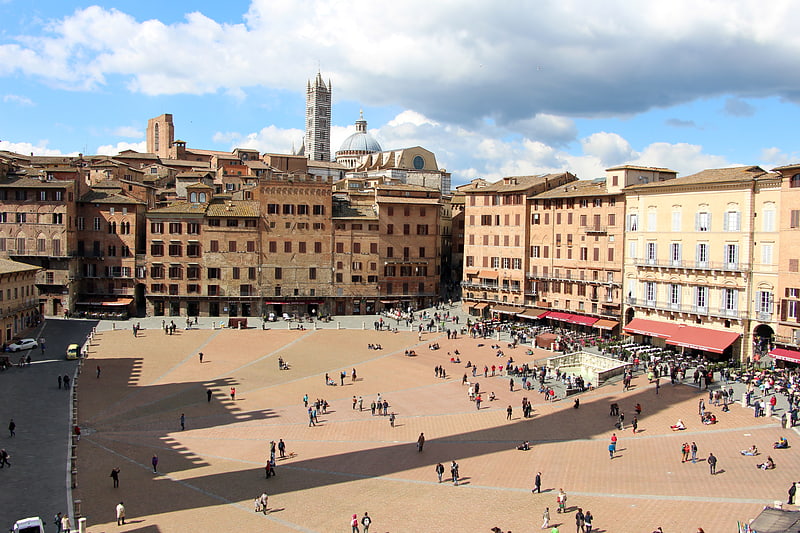
Square popular for public celebrations. Piazza del Campo is the main public space of the historic center of Siena, Tuscany, Italy and is regarded as one of Europe's greatest medieval squares. It is renowned worldwide for its beauty and architectural integrity. The Palazzo Pubblico and its Torre del Mangia, as well as various palazzi signorili surround the shell-shaped piazza. At the northwest edge is the Fonte Gaia.
The twice-a-year horse-race, Palio di Siena, is held around the edges of the piazza. The piazza is also the finish of the annual road cycling race Strade Bianche.[1]
Address: Il Campo, 53100 Siena
Siena Cathedral
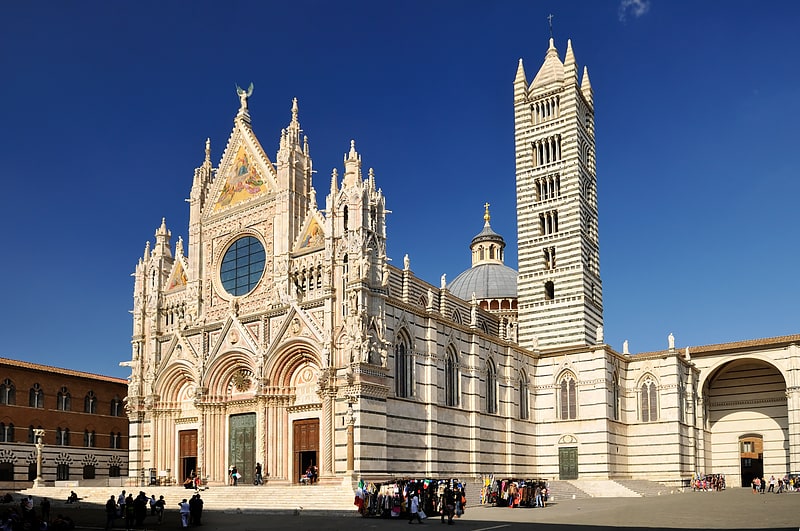
Also known as: Duomo di Siena
Romanesque-Gothic cathedral with mosaics. Siena Cathedral is a medieval church in Siena, Italy, dedicated from its earliest days as a Roman Catholic Marian church, and now dedicated to the Assumption of Mary.
It was the episcopal seat of the Diocese of Siena, and from the 15th century that of the Archdiocese of Siena. It is now the seat of the Archdiocese of Siena-Colle di Val d'Elsa-Montalcino.
The cathedral was designed and completed between 1215 and 1263 on the site of an earlier structure. It has the form of a Latin cross with a slightly projecting transept, a dome and a bell tower. The dome rises from a hexagonal base with supporting columns. The dome was completed in 1264. The lantern atop the dome was added by Gian Lorenzo Bernini. The bell tower has six bells, where the oldest one was cast in 1149. The nave is separated from the two aisles by semicircular arches. The exterior and interior are constructed of white and greenish-black marble in alternating stripes, with the addition of red marble on the façade. Black and white are the symbolic colors of Siena, etiologically linked to black and white horses of the legendary city's founders, Senius and Aschius. There are thirty-five statues of prophets and patriarchs grouped around the virgin. The finest Italian artists of that era completed works in the cathedral. These artists were Nicola and Giovanni Pisano, Donatello, Pinturicchio, Lorenzo Ghiberti, and Bernini.[2]
Address: Piazza del Duomo, 8, 53100 Siena
Palazzo Pubblico

Gothic style town hall building and tower. The Palazzo Pubblico is a palace in Siena, Tuscany, central Italy. Construction began in 1297 to serve as the seat of the Republic of Siena's government, which consisted of the Podestà and Council of Nine, the elected officials who performed executive functions.[3]
Address: Piazza del Campo, 1, 53100 Siena
Torre del Mangia

Iconic landmark tower and medieval belfry. The Torre del Mangia is a tower in Siena, in the Tuscany region of Italy. Built in 1338-1348, it is located in the Piazza del Campo, Siena's main square, next to the Palazzo Pubblico. When built it was one of the tallest secular towers in medieval Italy. At 102 m it is now Italy's second tallest after Cremona Cathedral's Torrazzo, the Asinelli tower in Bologna at 97 m being third.[4]
Address: Piazza del Campo, 53100 Siena
Palazzo del Magnifico

Tourist attraction in Siena, Italy. Palazzo del Magnifico, also known as Palazzo Petrucci, built as the residence of Pandolfo Petrucci, is located in Siena on Piazza San Giovanni at the corner of Via dei Pellegrini.[5]
Address: 1 Piazza San Giovanni, Siena
Museo dell'Opera del Duomo
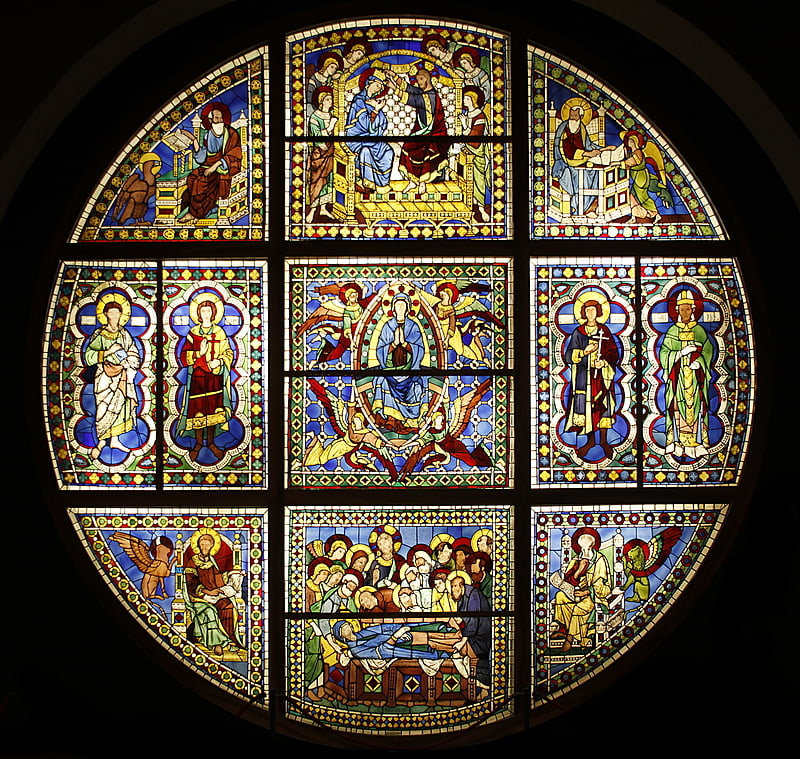
Museum in Siena, Italy. The Museo dell'Opera del Duomo is an art museum in Siena, in Tuscany in central Italy. It houses works of art and architectural fragments that were formerly in, or a part of, the Duomo of Siena. These include a number of Italian Gothic sculptures by Giovanni Pisano and his school from the façade of the cathedral; the Maestà of Duccio di Boninsegna, which was the altarpiece from about 1311 until 1505 or 1506; and works by Ambrogio and Pietro Lorenzetti. There are also works moved to the museum from other churches in the area, such as the Madonna of Duccio brought from the Pieve di Santa Cecilia at Crevole in the comune of Murlo.[6]
Address: Piazza Del Duomo, Siena
Palazzo Tolomei
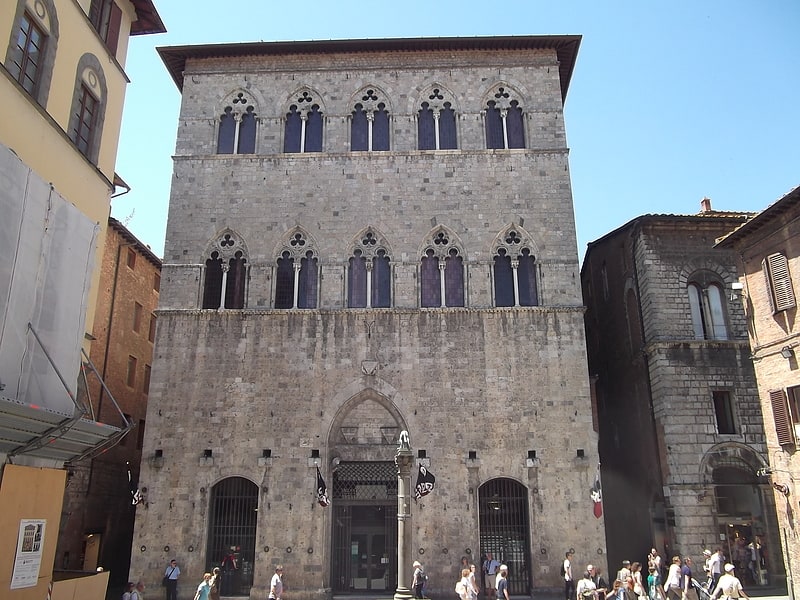
Palace in Siena, Italy. The Palazzo Tolomei is an imposing, Gothic style urban palace, located on Via Banchi di Sopra in the present contrada of Civetta, Terzo di Camollia of the city of Siena, region of Tuscany, Italy.[7]
Address: Via Banchi di Sopra, 29, 53100 Siena
Santa Maria della Scala
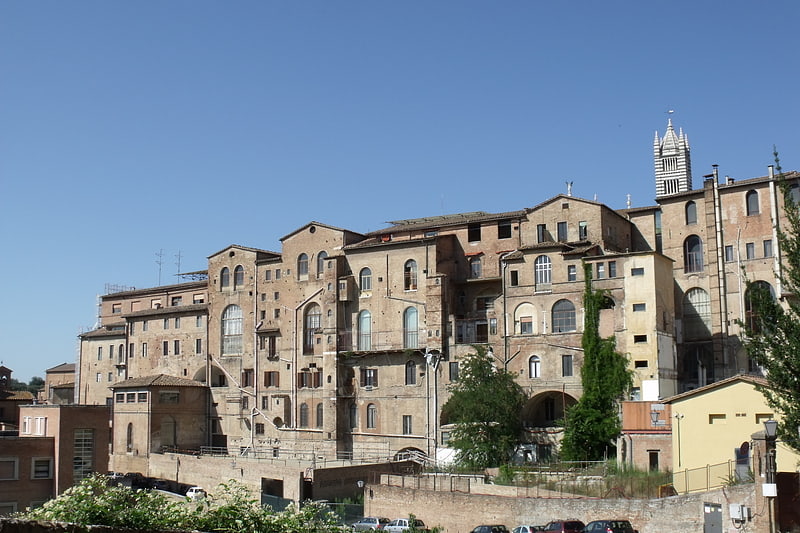
Museum in Siena, Italy. Santa Maria della Scala is located in Siena, Italy. Now a museum, it was once an important civic hospital dedicated to caring for abandoned children, the poor, the sick, and pilgrims. Revenues were earned partially from bequests and donations from the citizens of Siena, particularly the wealthy. The head of the hospital was the rector who managed the lay brothers responsible for its operation.
Santa Maria della Scala was one of Europe's first hospitals and is one of the oldest hospitals still surviving in the world. It played a major cultural role and is considered one of Siena's 3 main artistic hubs.[8]
Address: Piazza del Duomo 1, 53100 Siena
Palazzo Spannocchi
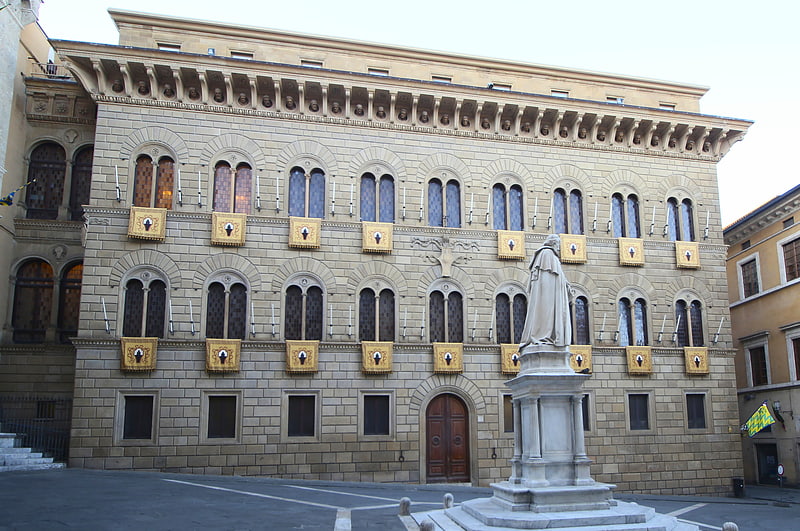
Palace in Siena, Italy. The Palazzo Spannocchi is a Renaissance style urban palace located on the Piazza Salimbeni, just off Via Banchi di Sopra in the Terzo di Camollia of the city of Siena, region of Tuscany, Italy. The building was associated with an ancient mercantile family of Siena.[9]
Address: Piazza Salimbeni, Siena
Palazzo Chigi-Saracini
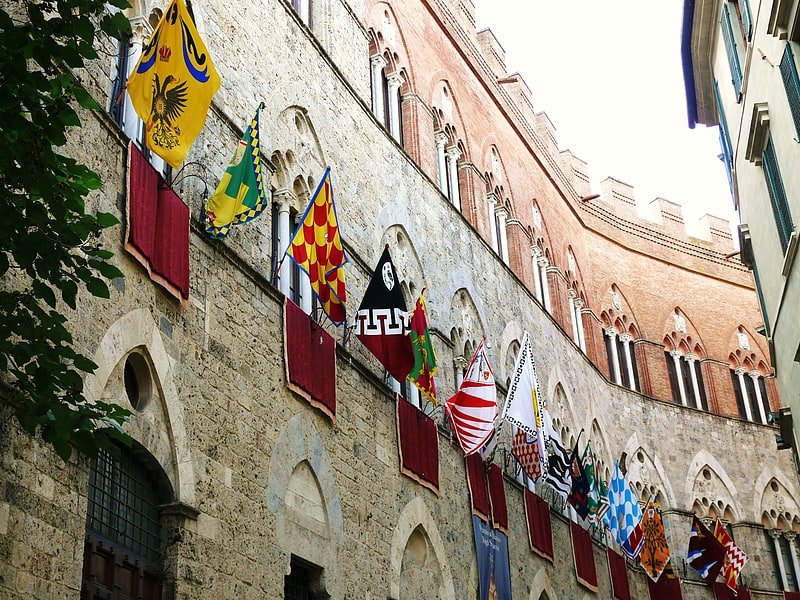
Palace in Siena, Italy. The Palazzo Chigi-Saracini is a Gothic urban palace on the Via di Città in the Terzo di Città in central Siena, Tuscany, Italy. In 2014 it housed the Accademia Musicale Chigiana.
It was built by the Marescotti family in the 12th century. It was the house of Count Galgano Lucarini Saracini and then it became property of Fabio Chigi Lucarini Saracini. The palace is described as a "Gothic beauty with a curved facade and back courtyard."[10]
Address: Via di Citta' 89, 53100 Siena
Fonte Gaia
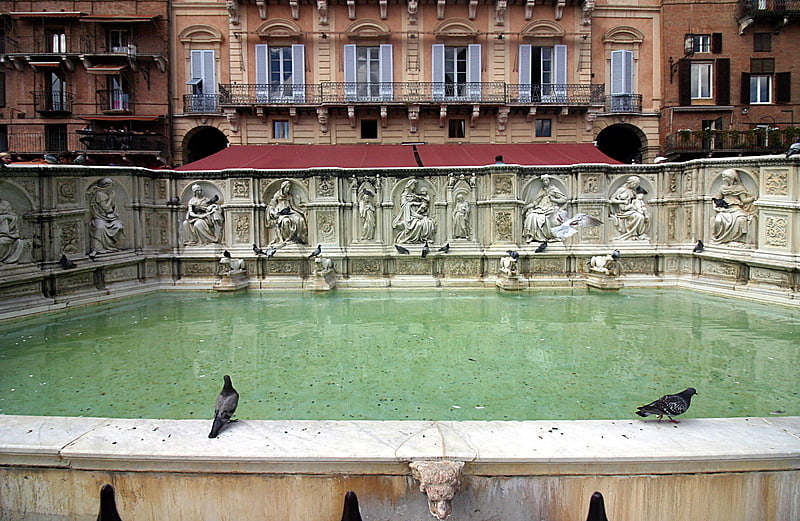
Historic fountain with reliefs and statues. The Fonte Gaia is a monumental fountain located in the Piazza del Campo in the center of Siena, Italy.
The first fountain in the Piazza del Campo was completed in 1342, after hydraulic construction had led water to the site. Underground pipes brought water to the site from 25 kilometers away. Legend holds that the fountain was met with much joy, thus it was given the name Gaia or joyous. Others suggest the term Gaia refers to the Latin term for "bride", and that the fountain was dedicated to the bride of God and patron of Siena, the Virgin Mary. The fountains, plates, and statues conflate Roman matrons' cardinal virtues, with a central relief of the Madonna and Child, curiously framed by stories of Genesis.
In 1419, the fountain had the present decorative frame constructed by Jacopo della Quercia. In 1858, the original marble panels were replaced by copies sculpted by Tito Sarrocchi, under the supervision of architect Giuseppe Partini. The side reliefs depict episodes from Genesis: The Creation of Adam and The Flight from the Garden of Eden. The wolves spouting water, representing the mother-wolf of Remus and Romulus, form part of the reconstructed fountain. Two nude female figures once adorned the front two columns, traditionally believed to represent Rea Silvia and Acca Larentia, in celebration of Siena’s supposed links to ancient Rome. These were not added in the reconstruction but can be viewed along with the original panels at a museum at Santa Maria della Scala, the old hospital overlooking the Piazza del Duomo. The long section of the fountain is adorned at the centre with a Madonna and Child, surrounded by allegories of the Virtues.[11]
Address: Piazza Il Campo, 23, Siena
Santa Maria dei Servi
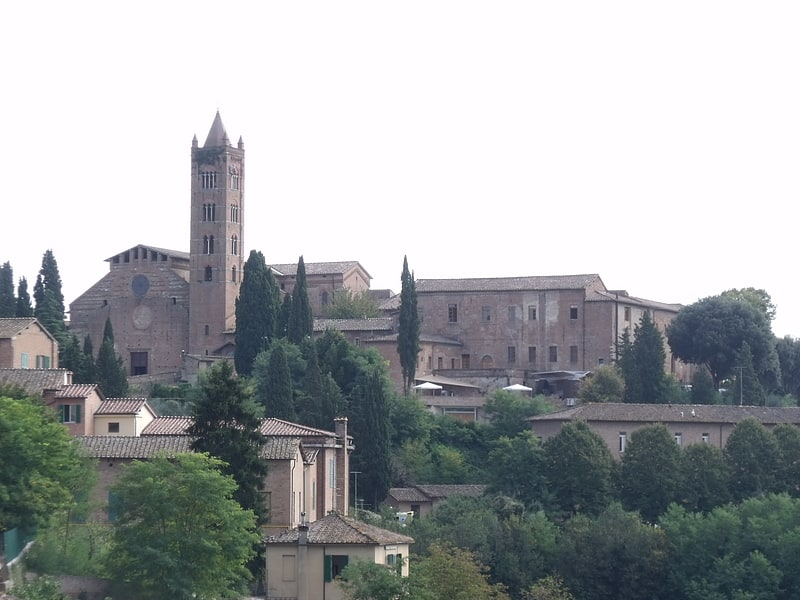
Romanesque-style church with Gothic art. The Church of Santa Maria dei Servi is a Romanesque style, Roman Catholic church in the Terzo of San Martino in the city of Siena, Tuscany, Italy.[12]
Address: Via Val di Montone, 53100 Siena
Basilica Cateriniana di San Domenico
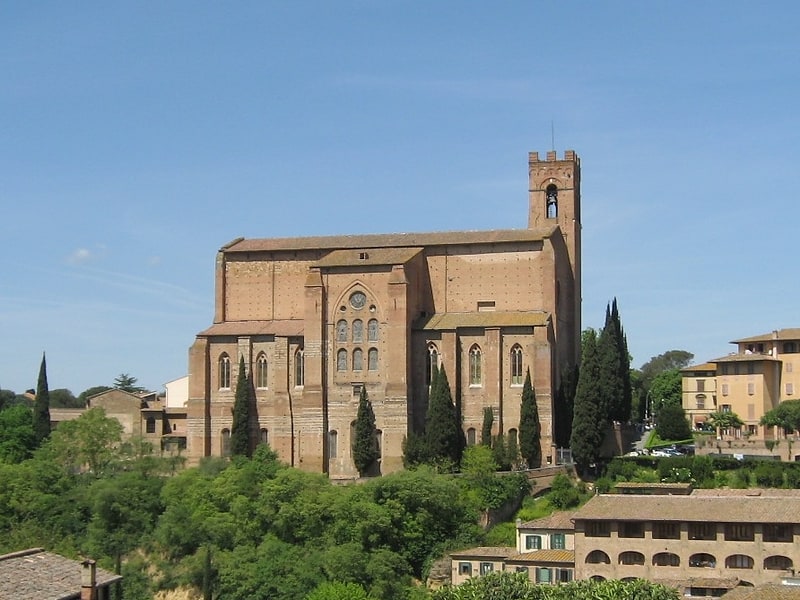
Also known as: Basilica di San Domenico
St Catherine's relics in 1200s cathedral. The Basilica of San Domenico, also known as Basilica Cateriniana, is a basilica church in Siena, Tuscany, Italy, one of the most important in the city.[13]
Address: Piazza San Domenico, 1, 53100 Siena
Oratory of the Compagnia di San Bernardino
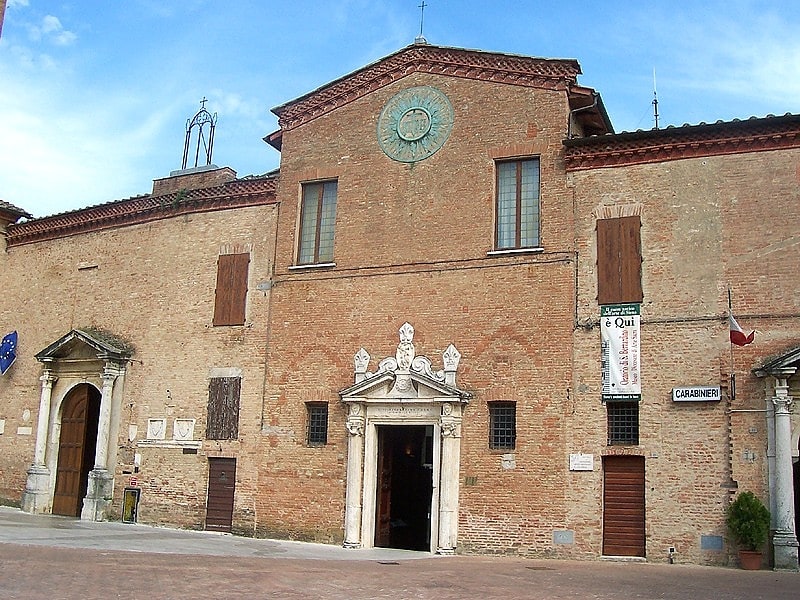
The Oratory of the Compagnia di San Bernardino is a place of worship in the Piazza San Francesco in Siena. Elevated to minor basilica status in 1925 by Pope Pius XI, it adjoins rooms housing the diocesan museum. It is notable for its frescoes from various 16th- and 17th-century Sienese painters like Sodoma and Domenico Beccafumi. The oratory is almost adjacent to the Basilica of San Francesco, Siena.[14]
Address: Piazza S. Francesco, 7, 53100 Siena
Palazzo Sansedoni
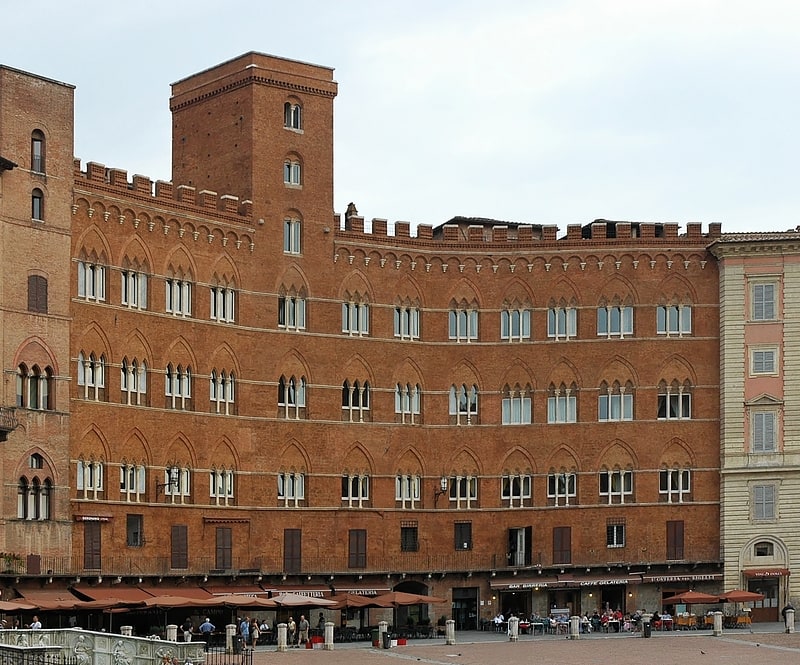
Palazzo Sansedoni is a Gothic style urban palace and tower, whose concave facade is situated facing the Palazzo Pubblico across the Piazza del Campo in the political center of the city of Siena, region of Tuscany, Italy.[15]
Address: Localita Banchi di Sotto 34, 53100 Siena
Pinacoteca Nazionale

Also known as: Pinacoteca nazionale
Art gallery housing Sienese masterpieces. The Pinacoteca Nazionale is a national museum in Siena, Tuscany, Italy. Inaugurated in 1932, it houses especially late medieval and Renaissance paintings from Italian artists. It is housed in the Brigidi and Buonsignori palaces in the city's center: the former, built in the 14th century, it is traditionally identified as the Pannocchieschi family's residence. The Palazzo Bichi-Buonsignori, although built in the 15th century, has a 19th-century neo-medieval façade based on the city's Palazzo Pubblico.
The gallery has one of the largest collections of Sienese paintings with gold backgrounds from the 14th and 15th centuries.
Works in the gallery include:
- Duccio di Buoninsegna's Polyptych N. 28 and Madonna of the Franciscans
- Guido da Siena's St. Peter Enthroned
- Simone Martini's Blessed Agostino Novello and His Miracles (c. 1330)
- Ambrogio Lorenzetti's Annunciation (c. 1344)
- Bartolo di Fredi's Adoration of the Magi
- Michelino da Besozzo's Mystical Marriage of Saint Catherine (c. 1420)
- Il Sodoma's Christ at the Column and Deposition
- Domenico Beccafumi's Birth of the Virgin, St. Michael Expelling the Rebel Angels, Coronation of the Virgin, Trinity Triptych, Marriage of St Catherine, Stigmatization of St. Catherine of Siena, St Lucy and Christ in Limbo
Other artists represented include Ugolino di Nerio, Pietro Lorenzetti, Sassetta, Domenico di Bartolo, Taddeo di Bartolo, Francesco di Giorgio Martini, Matteo di Giovanni, Neroccio di Bartolomeo[16]
Address: Via San Pietro, 29, 53100 Siena
Piazza del Duomo

Tourist attraction in Siena, Italy. Piazza del Duomo is a city square in Siena, Italy.[17]
Address: Via di Stalloreggi 15, 53100 Siena
Torre di Roccabruna

The Torre di Roccabruna is a medieval tower in Siena, central Tuscany, Italy.[18]
Address: 1 Vicolo San Pietro, Siena
Fortezza Medicea
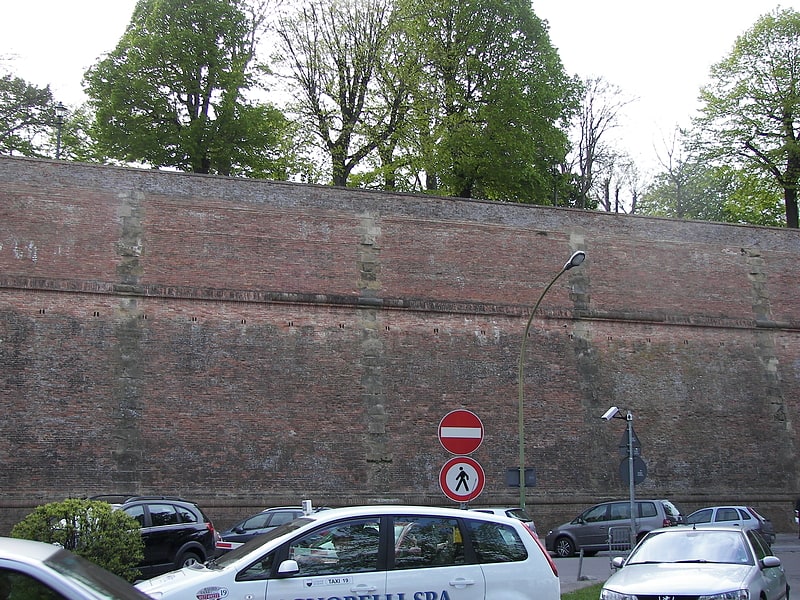
Tourist attraction in Siena, Italy. Siena’s Fortezza Medicea is a fort built in the city between 1561 and 1563 on the orders of Duke Cosimo, a few years before he became the first Grand Duke of Tuscany.
The fortress is positioned on the northern edge of the central Siena in the Terzo of Camollia, in the neighborhood of San Prospero, and since 1923 has overlooked the city’s Artemio Franchi/Montepaschi Arena.[19]
Address: Viale Vittorio Veneto, 53100 Siena
Palazzo Salimbeni
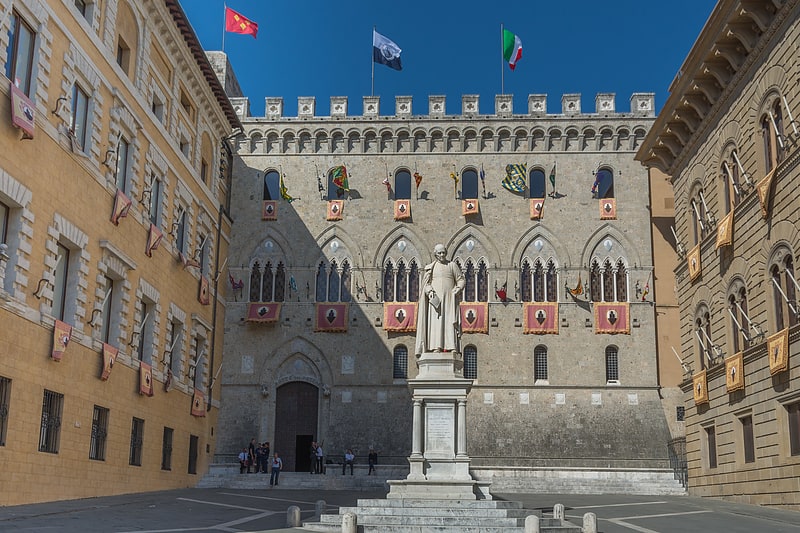
Palace in Siena, Italy. Palazzo Salimbeni is a Gothic style urban palace located on the Piazza Salimbeni, just off Via Banchi di Sopra in the Terzo di Camollia of the city of Siena, region of Tuscany, Italy. The building, associated with an ancient mercantile family of Siena, currently houses the main offices of the Banca Monte dei Paschi di Siena, one of the oldest banks in the world.[20]
Address: Piazza Salimbeni 3, 53100 Siena
San Vigilio
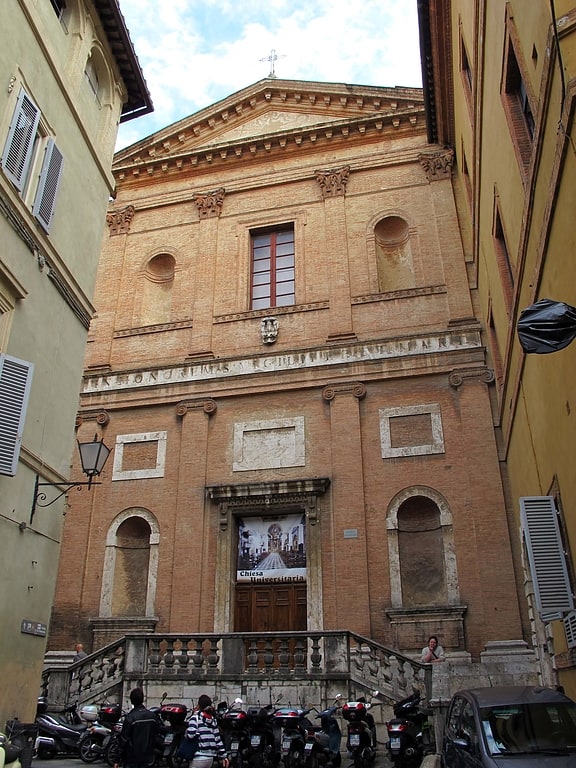
San Vigilio is a Renaissance and Baroque style, Roman Catholic church located on Via San Vigilio, Siena, region of Tuscany, Italy. The exterior has a sober classical facade, while the interior has rich Baroque decorations. The church is dedicated to the Bishop and martyr St Vigilius; it now serves as the chapel for the University of Siena. It stands across the street from the Castellare Ugurgieri, and down the street from the Palazzo Bandini Piccolomini found on the junction with Via Sallustio Bandini.[21]
Address: Via Sallustio Bandini, 48, 53100 Siena
Fontebranda
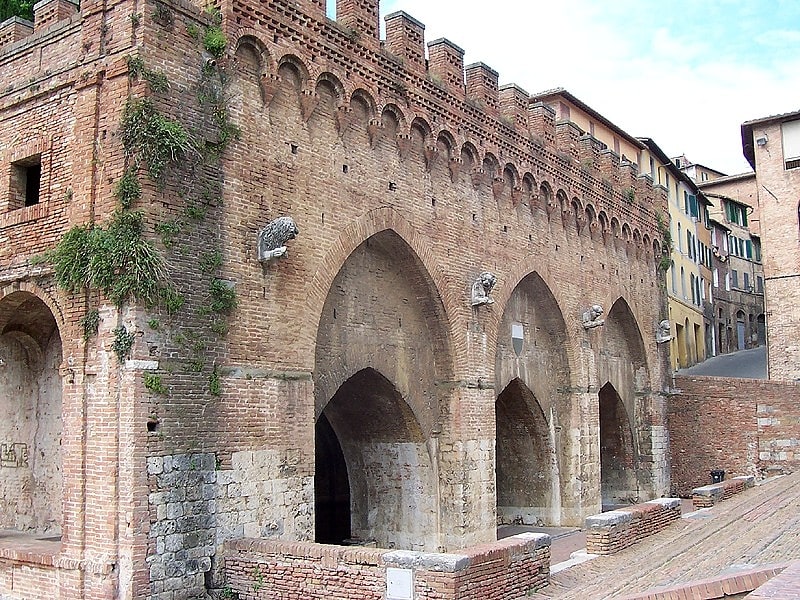
Historical landmark in Siena, Italy. Fontebranda is one of the medieval fountains of Siena, located in Terzo di Camollia, in the Contrada of Oca, near the Porta of Fontebranda.[22]
Address: Via di Fontebranda, Siena
Basilica dell'Osservanza
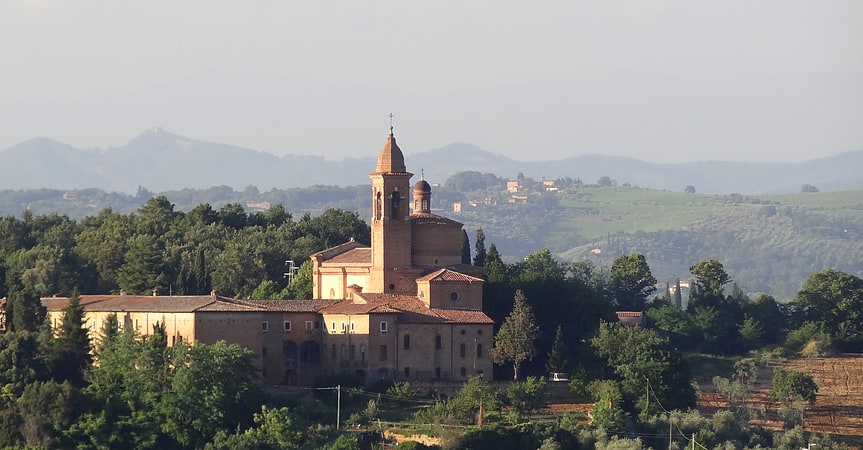
Reconstructed 15th-century church. The Basilica dell'Osservanza is a church on the outskirts of Siena, region of Tuscany, Italy.[23]
Address: Str. dell'Osservanza, 7, 53100 Siena
Santo Spirito
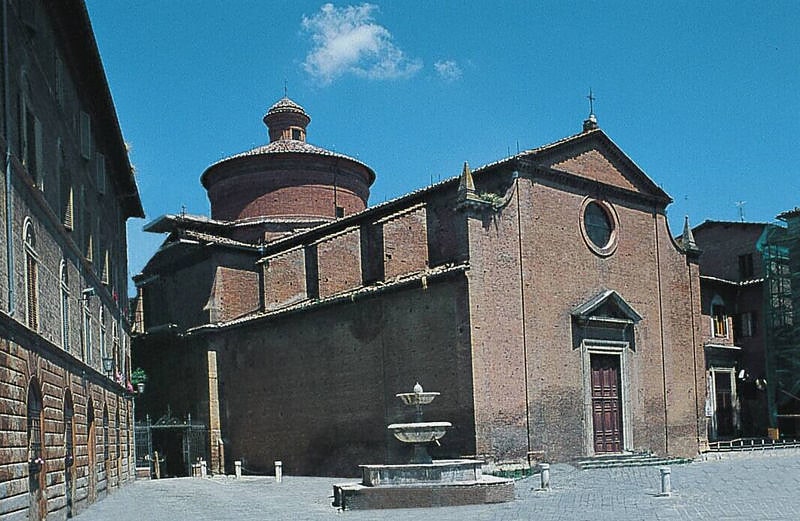
Catholic church in Siena, Italy. Santo Spirito is a Renaissance style, Roman Catholic church located in piazza Santo Spirito, where Via dei Pispini meets Vicolo del Sasso, in Siena, Italy.[24]
Address: Piazza Santo Spirito, Siena
Palazzo Piccolomini
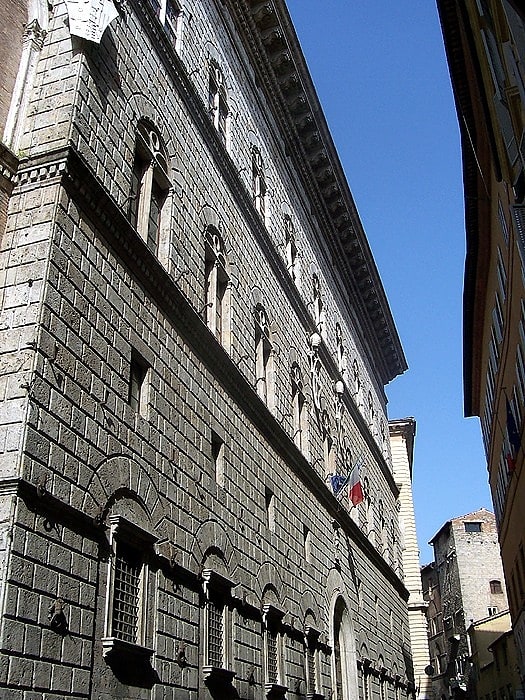
Palazzo in Siena, Italy. The Palazzo Piccolomini, also known as the Palazzo Todeschini Piccolomini is a Renaissance-style palace in the city of Siena, region of Tuscany, Italy. It is located on the Banchi di Sotto, at the corner with Via Rinaldini; uphill and west of the church of San Martino, the Loggia del Papa, and the Palazzo delle Papesse, which also built by a Piccolomini family member.[25]
Address: Localita Banchi di Sotto 52, 53100 Siena
Palazzo Chigi alla Postierla
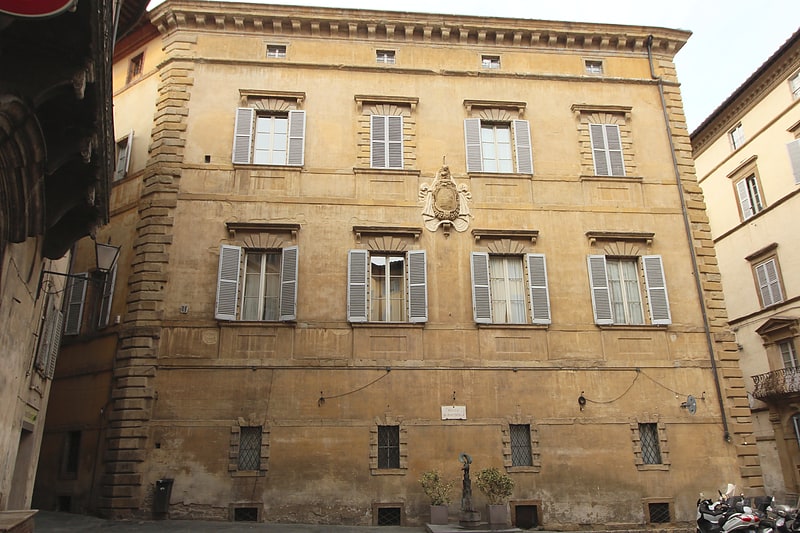
The Palazzo Chigi all Postierla, but sometimes referred also to as Chigi-Piccolomini or Piccolomini-Adami is a Renaissance style urban palace localized on Via del Capitano #1, corner Piazza Postierla, in the Terzo di Città, in the city of Siena, region of Tuscany, Italy. The palace is up the street from the Palazzo del Capitano del Popolo, Siena.[26]
Palazzo Fineschi Segardi
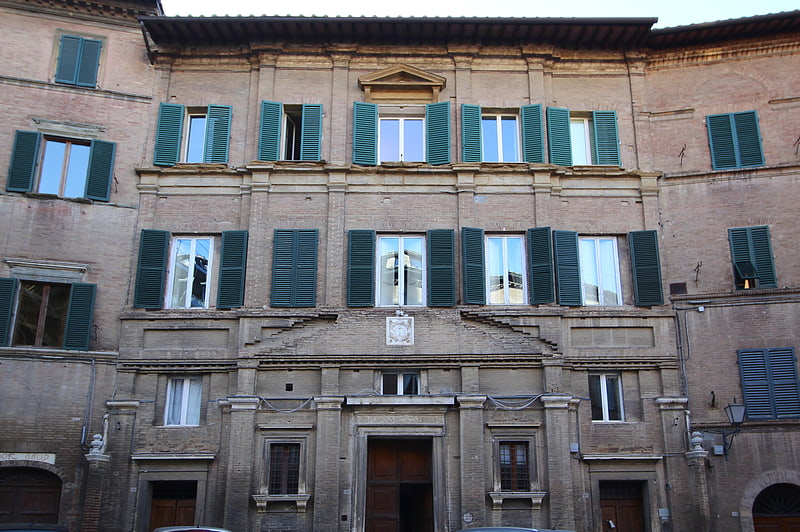
The Palazzo Fineschi Sergardi is a 16th-century urban palace located the Pian dei Mantellini neighborhood of the city of Siena, region of Tuscany, Italy. It is located near the Palazzo Celsi Pollini.[27]
Palazzo Celsi Pollini
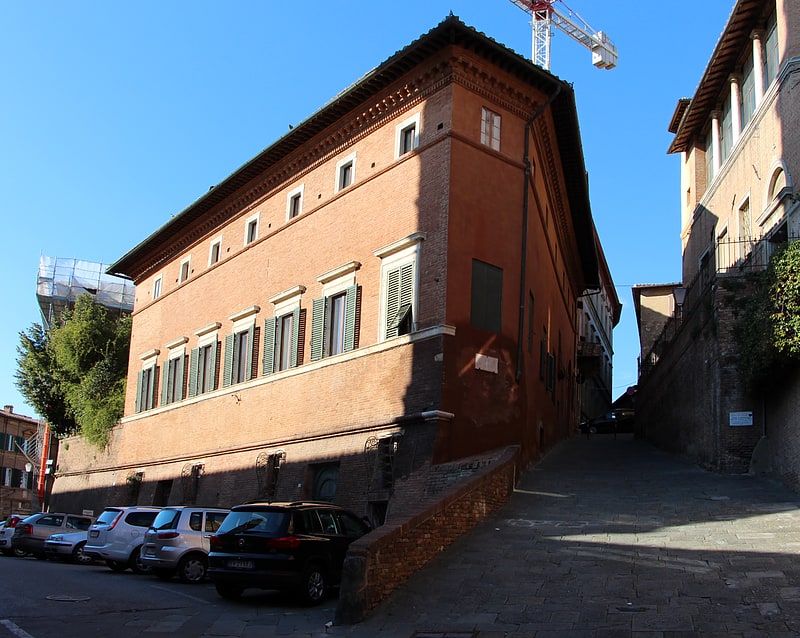
Palace in Siena, Italy. The Palazzo Celsi Pollini, once also called the Palazzo del Vescovo, is a Renaissance style urban palace in Siena, Italy. It is located on Pian dei Mantellini #39-41, at the corner with Via San Quirico. A 19th-century source refers to the house as Casa Campioni. The main facade faces the campanile of San Niccolò del Carmine.[28]
Palazzo Marsili
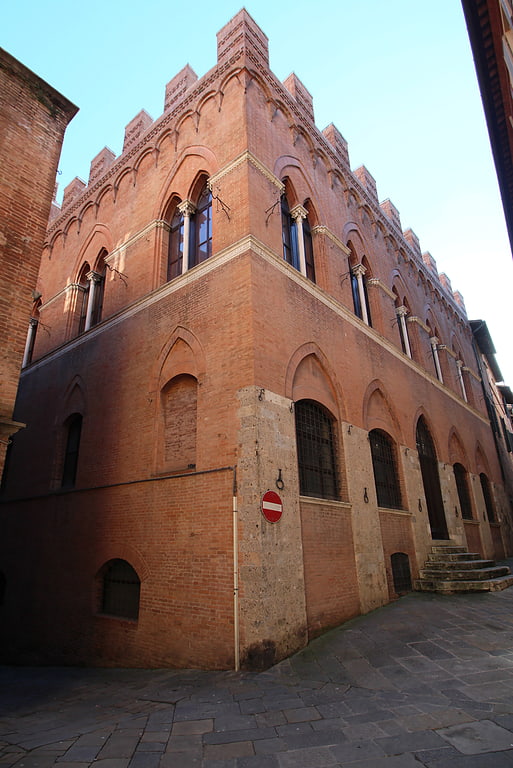
The Palazzo Marsili is a Gothic style urban palace localized on Via di Città #124-132, in the Terzo di Città, in the city of Siena, region of Tuscany, Italy. adjacent on Via di Città to the shorter brick Palazzo Marsili-Libelli with plain rectangular second and third story windows.[29]
Sinagoga di Siena
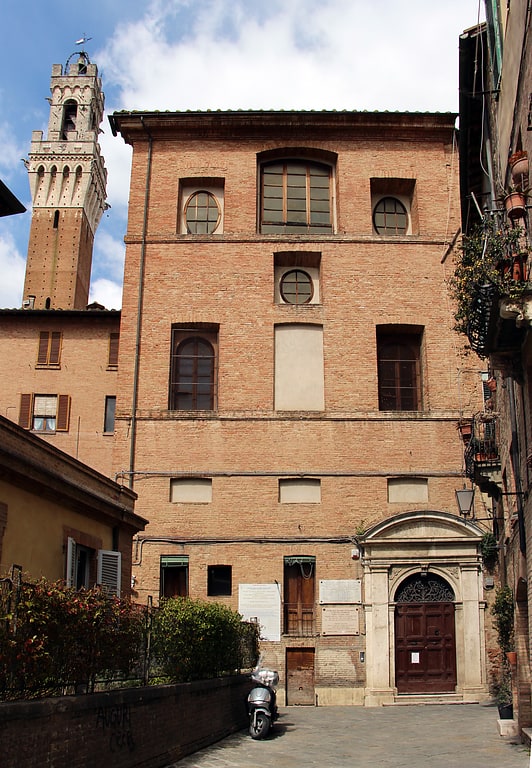
Synagogue in Siena, Italy. The Siena synagogue is a notable, historic synagogue in Siena, Italy.
A substantial Jewish community is recorded in Siena beginning in the 14th century. In 1571 the Medici restricted Jewish residence to a defined neighborhood, or ghetto, and it was in this neighborhood that a synagogue was built on the Vicole dell Scotte very close to the Piazza del Campo. The Jews were emancipated from the requirement of living in a ghetto in 1860.
The present synagogue was erected in 1786 on the site of the older synagogue. Because Jews in that era were prohibited from building houses of worship identifiable from the street, the stone facade of the four story building is plain, resembling neighboring residential buildings. The sanctuary is located on the first floor (one flight up from street level). It has an elaborate neoclassical interior, with a lofty baroque ceiling featuring a large crowned tablet of the Ten Commandments enthroned in clouds of glory. Two tiers of balconies on the building's third and fourth stories have views into the room through elaborate baroque grills. Furniture is arranged in the historic style of the Italian Jewish community, with the bimah in the center of the room. The Torah Ark is a classical marble cabinet with marble pillars and entablature towering almost the height of the room.
The architect was Giuseppe del Rosso of Florence, the master builders were Niccolo Ianda and Pietro Rossi.
The synagogue is open to visitors.
The historic Jewish cemetery of Siena also survives and is open to visitors.[30]
Address: Vicolo delle Scotte 14, 53100 Siena
San Cristoforo
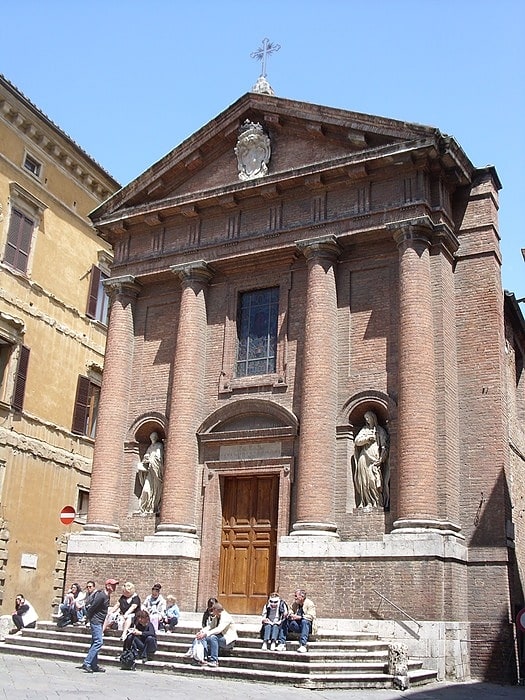
Catholic church in Siena, Italy. San Cristoforo is a Roman Catholic church located on Piazza Tolomei in the Northern Terzo di Camollia and contrada of Civetta in the city of Siena, region of Tuscany, Italy. Across the piazza from the church is the Palazzo Tolomei, one of the oldest buildings in the city. The Tolomei for many years were associated with the church.[31]
Address: Piazza Tolomei, 53100 Siena
Battistero di San Giovanni
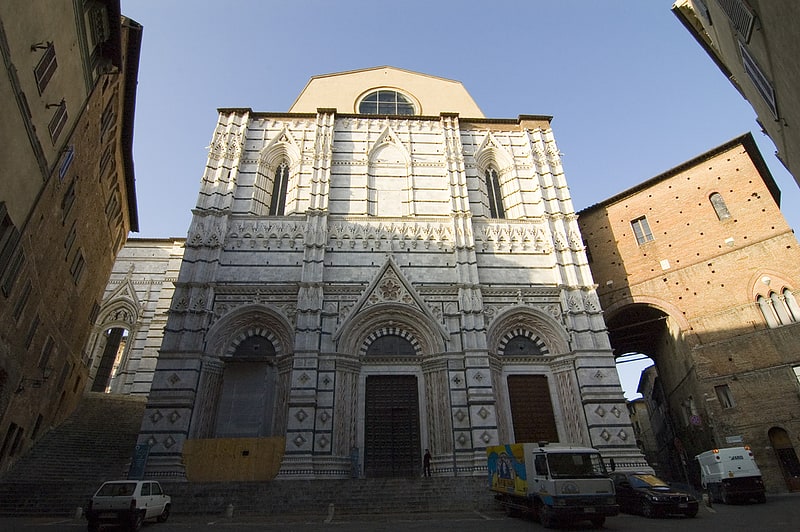
Cathedral building with frescoes and font. The Battistero di San Giovanni is a religious building in Siena, Italy. It is in the square with the same name, near the final spans of the choir of the city's cathedral.
It was built between 1316 and 1325 by Camaino di Crescentino, the father of Tino di Camaino. The façade, in Gothic style, is unfinished in the upper part, such as the apse of the cathedral.
In the interior, the rectangular hall, divided into a nave and two aisles by two columns, contains a hexagonal baptismal font in bronze, marble and vitreous enamel, realized in 1417-1431 by the main sculptors of the time: Donatello (panel of "Herod's Banquet" and statues of the "Faith" and "Hope"), Lorenzo Ghiberti, Giovanni di Turino, Goro di Neroccio and Jacopo della Quercia (statue of John the Baptist and other figures). The panels represent the Life of John the Baptist, and include:
- "Annunciation to Zacharias" by Jacopo della Quercia (1428-1429)
- "Birth of John the Baptist" by Giovanni di Turino (1427)
- "Baptist Preaching" by Giovanni di Turino (1427)
- "Baptism of Christ" by Ghiberti (1427)
- "Arrest of John the Baptist" by Ghiberti and Giuliano di Ser Andrea
- "The Feast of Herod" by Donatello (1427)
These panels are flanked on the corners by six figures, two by Donatello ("Faith" and "Hope") in 1429; three by Giovanni di Turino ("Justice", "Charity" and "Providence", 1431); and the "Fortitude" is by Goro di Ser Neroccio (1431).
The marble shrine on the font was designed by Jacopo della Quercia between 1427 and 1429. The five "Prophets" in the niches and the marble statuette of "John the Baptist" at the top are equally by his hand. Two of the bronze angels are by Donatello, three by Giovanni di Turino (the sixth is by an unknown artist).
The frescoes are by Vecchietta and his school (1447-1450, Articles of Faith, Prophets and Sibyls), Benvenuto di Giovanni, the school of Jacopo della Quercia e, perhaps, one by Piero Orioli. Vecchietta also painted two scenes on the wall of the apse, representing the Flagellation and the Road to Calvary. Michele di Matteo da Bologna painted in 1477 the frescoes on the vault of the apse.[32]
Address: Piazza S. Giovanni, 53100 Siena
Teatro dei Rozzi
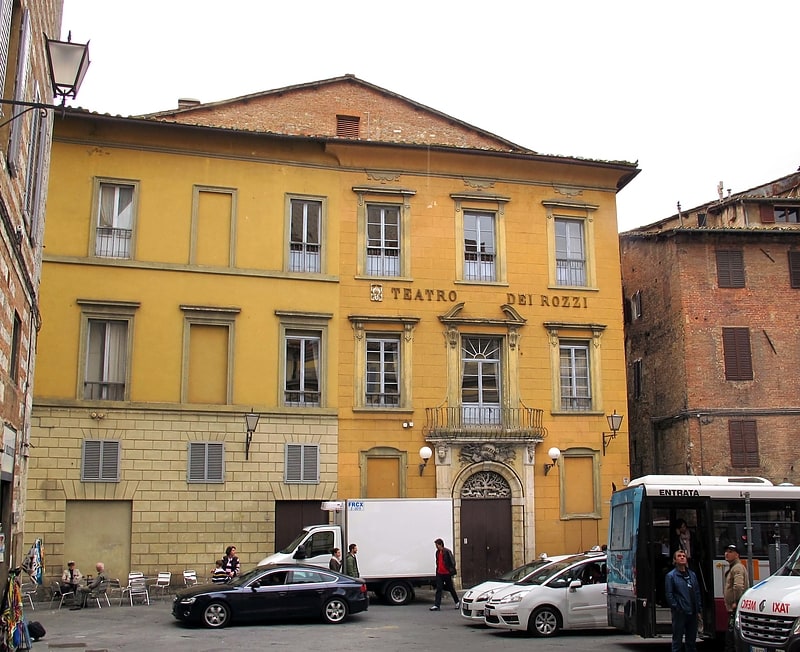
Theater in Siena, Italy. The Teatro dei Rozzi is a live-performance theater located on Piazza Indipendenza #15, in the city of Siena, region of Tuscany, Italy; while this structure was inaugurated in 1817, the sponsoring organization dated to 1531.[33]
Address: Piazza Indipendenza, 15, 53100 Siena
Basilica of San Francesco

Also known as: Basilica di San Francesco
Gothic church with a spare interior. San Francesco is a basilica church in Siena, Tuscany, Italy.
It was erected in c. 1228-1255 and later enlarged in the 14th-15th centuries, the original Romanesque edifice being turned into the current large Gothic one.[34]
Address: Piazza S. Francesco, 6, 53100 Siena
Santa Maria in Provenzano
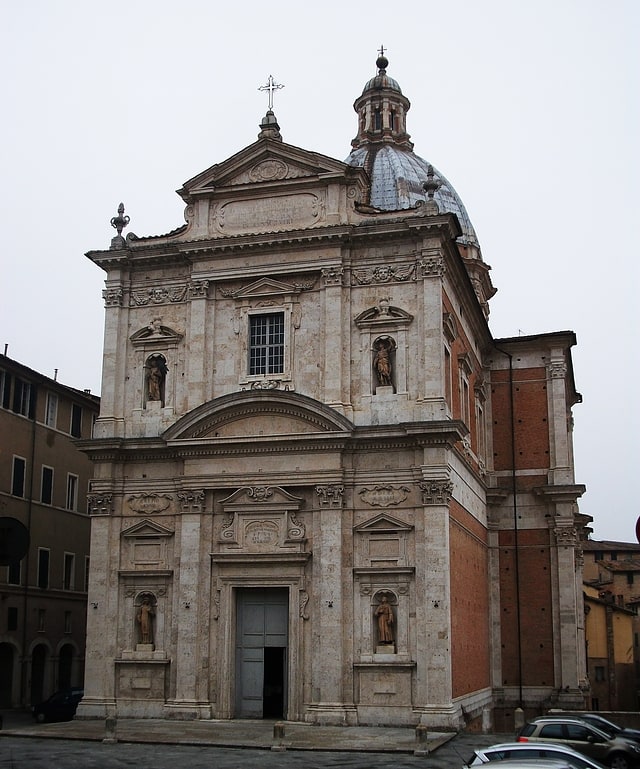
Also known as: Chiesa di Santa Maria di Provenzano
Collegiate church in Siena, Italy. Santa Maria in Provenzano, or the Insigne Collegiata di Santa Maria in Provenzano, is a late-Renaissance-Baroque style, Roman Catholic, collegiate church in Piazza Provenzano Salvani, in the Terza Camollia, just southwest of the basilica of San Francesco, in the city of Siena, region of Tuscany, Italy. This Marian shrine was built around a 14th-century terracotta icon of the Madonna, which was credited with miracles. The Palio of Siena takes place on the day of veneration of this Marian devotion.[35]
Address: Piazza Provenzano, 53100 Siena